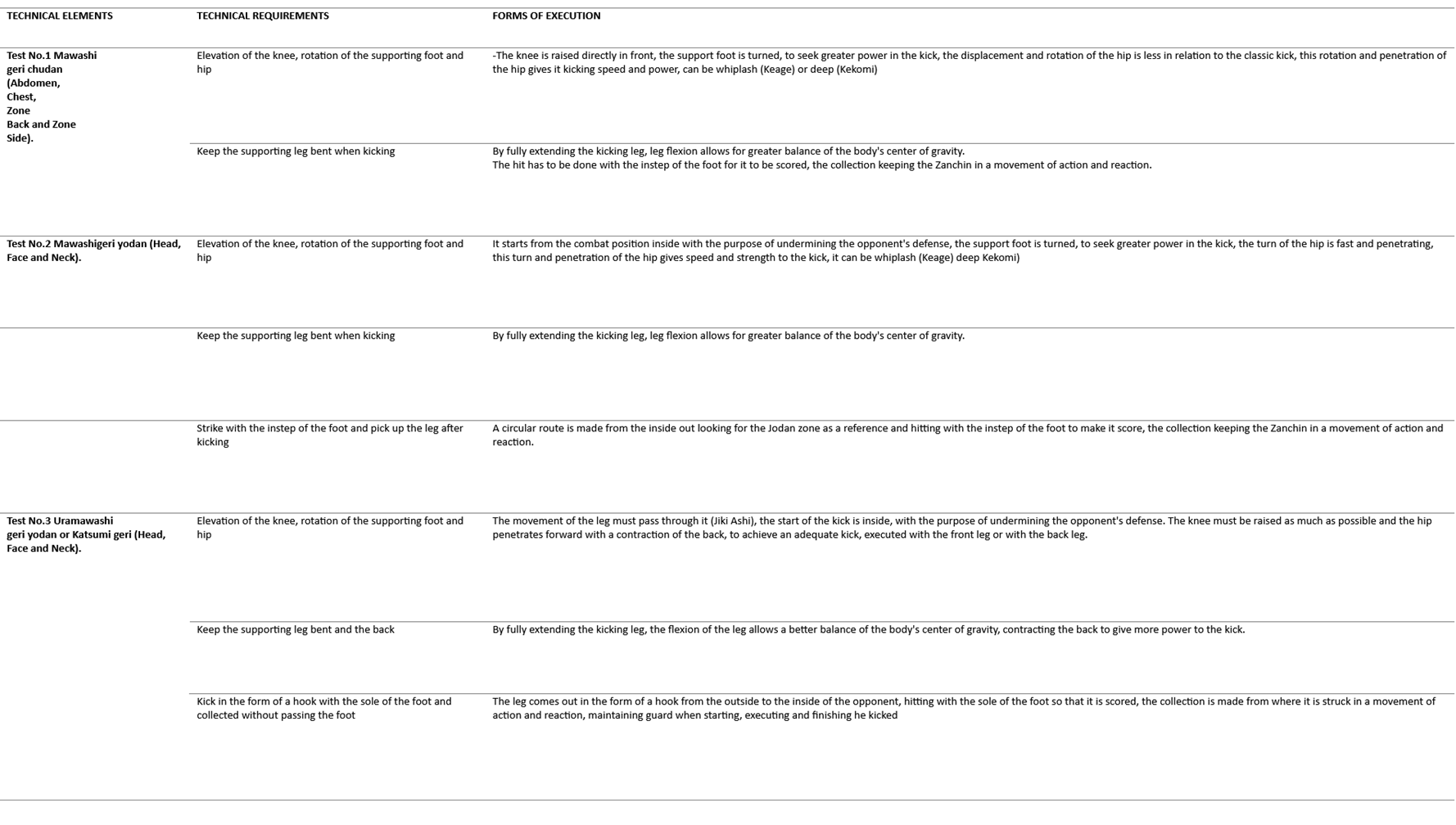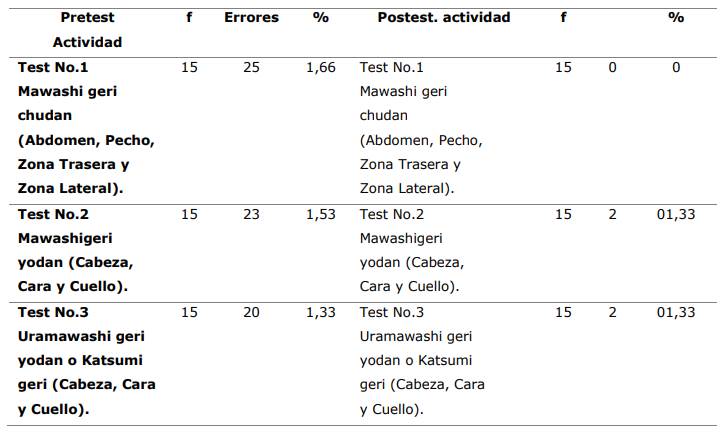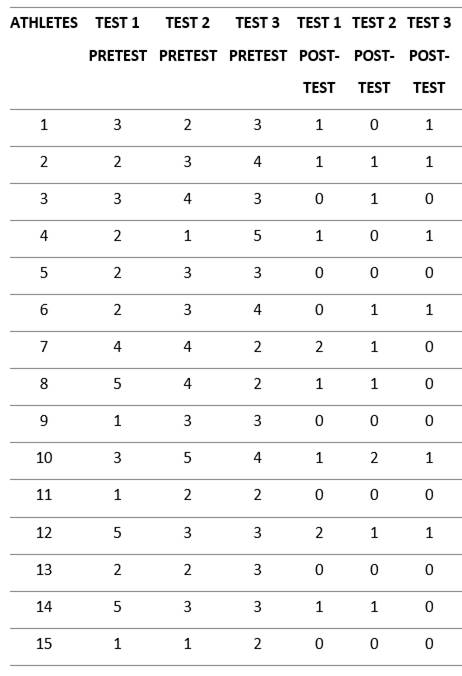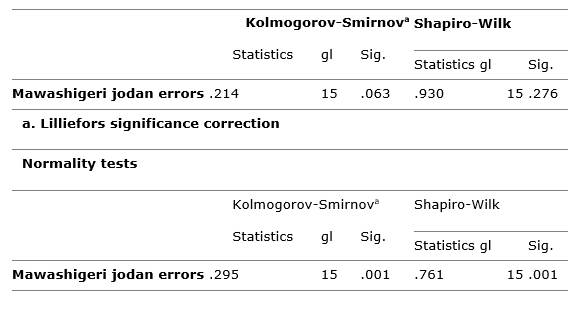Mi SciELO
Servicios Personalizados
Articulo
Indicadores
-
 Citado por SciELO
Citado por SciELO
Links relacionados
-
 Similares en
SciELO
Similares en
SciELO
Compartir
Ciencia y Deporte
versión On-line ISSN 2223-1773
Ciencia y Deporte vol.7 no.3 Camagüey sept.-dic. 2022 Epub 03-Sep-2022
http://dx.doi.org/10.34982/2223.1773.2022.v7.no3.003
Original article
Sport Planning Strategy for Karate-do in Multiple Competitions
1Universidad de Guayaquil, Guayaquil, Ecuador.
Introduction:
The contents expressed in this paper about the sports planning strategy for karate-do in multiple competitions, applied to kumite, is an experimental research study in the form of pedagogic pre-experiments through which the efficacy of the planning system to learn the kumite technique by the 15 athletes within the 16-17 category was evaluated.
Aim:
To determine the effectiveness of the kumite technical tests applied to athletes from the Sports Federation of Guayas who took part in multiple competitions.
Method:
This experimental research in the form of pedagogic preexperiment helped corroborate the efficacy of the planning system of the kumite technique by the 15 athletes within the 16-17 category, accounting for 100% of the population available in this age group engaged in karate-do.
Results:
As a result, the null Ho hypothesis was rejected, while the alternative hypothesis Hi was confirmed, assuming that the data did not have a normal distribution (P = 0.31 > á = 0.05) during the pre-test (normal distribution). However, the test results showed that P = 0.00 d" á = 0.05, demonstrating that the data did not have a normal distribution. The Wilcoxon rank test showed P 0.00 < 0.05, so the null hypothesis was rejected, and the alternative hypothesis was accepted. It was inferred that there was a significant difference between the number of errors made by the athletes in the first and second test of Ura Mawashi geri jodan or Katsumi geri upon the implementation of the proposal, leading to a significant reduction of errors during the post-test.
Conclusions:
Its implementation favored the technical-competitive performance of karate athletes, which demonstrated the pertinence of the test, based on the scientific-methodological treatment needed for preparedness.
Key words: karate-do; multiple competitions; planning.
INTRODUCTION
Motor praxis is defined as the science of motor action, as the modes of functioning and the results after implementation; it is the process of developing or implementing motor conducts. Motor action is observable, but also interpreted and systematized. In combat sports, both contenders make constant decisions during the bout, which are translated into motor actions. This study only relies on the reactions that offer objective and subjective data characterizing a motor function. The motor situation may demand an immediate or stated decision as the preestablished motor task.
Following the above criteria, both contenders are expected to hide their emotions at all times, and prevent that the opponent figures out the new actions of the attacker or the one receiving the attack, since they are intended to product an advantage over the adversary. When the communication is established with the opponent, they are showed what the other wants to, the opponent is being told what is being done and what will be done. Only that none of these actions are meaningful for the score. This type of communication is used with the opponent to check their immediate reactions and set up a new mode of communicating.
Karate-do is a universally-practiced sport that joins several styles; it is represented by the World Karate-Do Federation (WKF), whose member states mount to over 173, through 123 different styles. However, only four styles are recognized for competition (traditional styles associated with the origin of the sport), namely, Shotokan Ryu, Goju Ryu, Shito Ryu, Wado Ryu. The other styles are equally important, according to the International Competition Rules, December 2005 (version 5.5) http://www.wkf.net.
Moreover, various actors coincide in that this modality is a bout that takes place between two contenders, using karate-do techniques of different nature. Other authors note that the work of technicians is the basic link of karate-do.
However, kumite is not included in the bibliography abundantly, as there are not many documents that contribute to it methodologically, along with the negative influence of the absence of a comprehensive methodology on the teaching-learning process, specifically related to the technical elements. They also refer that “kumite is one of the major elements in martial arts teaching and development”. All the preparatory kihon, the katas, and their application, including the physical training of karateka have the same goal: “Kumite” or real combat. Some of these authors are, Bisso, D. (2007) Argel M., (2019), Brailovsky, D. (2018). Carrusel. (2015). Leal, I., & Camacho, R. (2018). Lopes, J. C. (2018), Quinto. D. C. (2020).
According to Guillén, L. (2009) cited by Martínez, R. (2010), kumite is a close-range combat in which the contenders use punching, blocking, and kicking at different distances; also, the single kata, team kata, team kumite, single kumite, free kumite with different levels of attack and a strong influence of the technical-tactical thinking (p.30).
Based on the previous criteria, kumite is a fight in which the techniques practiced in theory during the katas are applied against a real opponent. Correction and meticulousness of the techniques are essential, the athlete demonstrates their physical skills in the competition. This is a complex task for beginners, who only after some time, can acquire the capacity of concentration and domain of their bodies needed to execute every technique effectively and vigorously. At early ages, the athletes are still creating the capacities to master all the technical elements of kumite.
Upon an analysis of the competitive rules, the cognitive levels at these ages, the technical demands of kumite are directed to some combat techniques, mainly those commonly used and easy to execute, such as, combat position, combat movements, mae te tsuki, gyako tsuki arm techniques, and two steps (mae te and gyako tsuki), mawashi geri jodan (up) leg techniques, and chudan (mid-level), ura mawashi geri or katsumi geri, blocks using the arms and a combination of the previous techniques.
Moreover, Argel M., (2019), Martínez, R. (2010), Alicia Riveiro-Bozada et,al (2016), Carranza Alcántar, M. d. (2017). Cevallos, M. (2017). Leal, I., & Camacho, R. (2018). López, J. C. (2018), Suárez-Montes, N., Sáenz-Gavilanes, J., & Mero-Vélez, J. (2016) coincided in that through these technical elements of kumite practitioners can achieve significant results in their categories. However, the other technical elements are also a complementary part in athlete preparedness or as an approximation to these techniques, so when the athletes go through the next categories, they will acquire these contents, as they are more complex and harder to execute, such as falls, projections, spinning kicks, etc. The athlete then has acquired greater cognitive and muscle development.
An assessment of the findings of the above authors tells us that the application of combination techniques in kumite is a method whose meaning is “pre-set combat” that has different phases of the progress the athletes will make to get closer to free combat or Jo kumite. Its structure is very simple; the two athletes assume the role of the attacker by turns.
Kihon kumite is the basic form of training with a partner. It is about executing the techniques learned in kihon. It shows the dimension of how to use them against an opponent who is also moving, attacking, and defending. Training must be done with time, speed, constancy, and the focused-mind approach, maximum of respect to the opponent (whoever and whatever the level is). It allows people to learn tempos, rhythms, to train speed, accuracy, strength, etc. There are several forms of kihon kumite, depending on the number of techniques, Ippon kumite: attack, defense and counter-attack; Sambon kumite: three consecutive attacks, a stop, and counter-attack.
According to Guillén, L. (2009) cited by Martínez, R. (2010) Karate is made of different groups of technical elements to facilitate a better understanding of its use; so, for a satisfactory teaching-learning process of the technical fundaments, the following approaches are implemented.
Kata: an imaginary combat against one or several opponents using classical techniques or their variants.
Kumite: person to person or real combat.
Kata Bunkai: A logical interpretation of Kata, based on the implementation of the technical fundaments, body-to-body work (combat). Kata is executed with opponents, following the same angles of all the techniques.
Bunkai kumite: It consists in the execution of the different techniques of Kata, without repeating them; their order will be the same of Kata. It will include pairs in kumite position; when the basic technique is used, it will include projections or any other technique added.
Oyo Bunkai: It is a creative and free continuation, which allows for all possible executions of a technique.
Kata-kumite: This phase will only start from the third Kyu on, it consists of the execution of kata with rhythm, position, and kumite punching. On a first stage, it will be individual, though the upper stage will include opponents.
Kihon Kumite: Fundaments of the combat that must be executed by pairs whose purpose is real contact between two opponents, the practice of technical elements during face-to-face combat, which is divided into:
ƒ Gojon Kumite: Five-attack combat.
ƒ Sambon Kumite: Three-attack combat.
ƒ Ippon Kumite: One-attack combat.
ƒ Jiyu Ippón Kumite: Simulation of real combat that may be conceived in such a way that the information given to the contender be total, partial, or null (pre-set work).
ƒ Jiyu Kumite: Free combat.
ƒ Kihon Shiai Kumite: Preparatory exercises so that the students face sports combat (sports combat kihon).
ƒ Shiai Kumite: Combat following regulations, or competition. It aims to learn to defend and attack initially. It is necessary to learn how to execute it against the opponent’s body, at the exact time, with the adequate movements, distance and hip movements to strengthen the punching power, making this technique more effective.
Accordingly, the purpose of this research was to determine the effectiveness of the kumite technical tests applied to athletes from the Sports Federation of Guayas who took part in multiple competitions.
MATERIALS AND METHODS
This experimental research provided an explanation of the facts associated with the cause-effect relation, using a 15-athlete sample.
This experimental research in the form of pedagogic pre-experiment helped corroborate the efficacy of the planning system of kumite technique by the 15 athletes within the 16-17 category, accounting for 100% of the population available in this age group engaged in Karate-do, who belong to the Sports Federation of Guayas, in the city of Guayaquil, the Republic of Ecuador. The methods used were the deductive, inductive, statistical, and documentary, which guided the research process.
RESULTS AND DISCUSSION
The T-test was performed to the samples to corroborate the research hypothesis, which demonstrated that the data had a normal distribution (p ≥ 0.05). This test was run for the kumite technique execution; the variations made to execute them, which followed these steps (Table 1).
Test evaluation to measure execution quality
From 1 error evaluation of excellent.
From 2 errors evaluation of very good.
Out of 3 errors evaluation of good.
From 4 to regular evaluation errors.
Of 5 or more errors evaluation of wrong.
Table 1 shows that the results of the pre-test run to the athletes were lower than the post-test, compared to the general test. It demonstrated that the current methodology hinders technique mastery and the athlete’s integrated training. However, following the implementation of the sports planning strategy for karatedo in multiple competitions showed significant results, demonstrating the efficacy of the alternative, since the errors made in the pre-test accounted for over 75%, and declined in the post-test below 30% (Table 2 and Table 3).
Technical test to competitive kumite. Advanced variations to perform kumite
Table 3. - Results of the technical kumite test to athletes in multiple competitions to measure the execution quality of 15 athletes in the 16-17-year-old category, belonging to the Sports Federation of Guayas, city of Guayaquil
| No | Pre-test errors | % | Eval | No | Post-test errors | % | Eval |
| 1 | 5 | 5 | B | 1 | 1 | 0.1 | VG |
| 2 | 4 | 4 | A | 2 | 1 | 0.1 | VG |
| 3 | 3 | 3 | G | 3 | 1 | 0.1 | VG |
| 4 | 4 | 4 | A | 4 | 1 | 0.1 | VG |
| 5 | 5 | 5 | B | 5 | 0 | 0 | E |
| 6 | 3 | 3 | G | 6 | 1 | 0.1 | VG |
| 7 | 4 | 4 | A | 7 | 0 | 0 | E |
| 8 | 6 | 6 | B | 8 | 1 | 0.1 | VG |
| 9 | 5 | 5 | B | 9 | 1 | 0.1 | VG |
| 10 | 7 | 7 | B | 10 | 1 | 0.1 | VG |
| 11 | 4 | 4 | A | 11 | 0 | 0 | E |
| 12 | 6 | 6 | B | 12 | 1 | 0.1 | VG |
| 13 | 5 | 5 | B | 13 | 0 | 0 | E |
| 14 | 3 | 3 | G | 14 | 0 | 0 | E |
| 15 | 4 | 4 | A | 15 | 0 | 0 | E |
The results of the technical test performed to the kumite athletes to determine the technical quality level in the pre-test were very low individually; only two athletes were assessed as good. However, following the implementation of the strategy for kumite competition planning in multiple events, it was effective, as all the athletes were assessed as very good and excellent, meaning they were ready for competition (Table 4).
The normality test to the pre-test and post-test variables in Test No 1 Mawashi geri chudan, was performed upon determining the following hypotheses:
Ho: If P > α=0.05, there is a normal distribution of data.
Hi: If P < α=0.05, there is no normal distribution of data.
As a result, the null Ho hypothesis was rejected, while the alternative hypothesis Hi was confirmed, assuming that the data did not have a normal distribution (P = 0.36 > α = 0.05) during the pre-test (normal distribution). However, the post-test results showed that P = 0.02 ≤ α = 0.05 through the Shapiro Wilk test, demonstrating that the data did not have a normal distribution which could be corroborated in the following tables (Table 5 and Table 6).
Hence, since one of the samples had a not normal data distribution, the nonparametric Wilcoxon rank test was run with the following results (Table 7).
Table 7. - Testa statistics
| Mawashi geri chudan errors | |
| Z | -3.448b |
| Asymptotic sig. (two-sided) | .001 |
a.Wilcoxon rank test. Based on positive ranks.
The Wilcoxon rank test showed that P 0.01 < 0.05, so the null hypothesis was rejected, and the alternative hypothesis was accepted. It was inferred that there was a significant difference between the number of errors made by the athletes in the first and second Mawashigeri chudan test, and the second test upon the implementation of the proposal, leading to a significant reduction of errors during the second measurement.
The normality test to the pre-test and post-test variables in Test No 2 Mawashi geri jodan, was performed upon determining the following hypotheses:
Ho: If P > α=0.05, there is a normal distribution of data.
Hi: If P < α=0.05, there is no normal distribution of data.
As a result, the null Ho hypothesis was rejected, while the alternative hypothesis Hi was confirmed, assuming that the data do not have a normal distribution (P = 0.276 > α = 0.05) during the pre-test (normal distribution). However, the post-test results showed that P = 0.01 ≤ α = 0.05, demonstrating that the data did not have a normal distribution which could be corroborated in the following tables (Table 8 and Table 9).
Hence, the non-parametric Wilcoxon rank test was run, since one of the variables showed a not normal distribution. The test showed the following results:
Table 9 - Testa statistics
| Mawashigeri jodan errors - Mawashigeri jodan errors | |
| Z | -3.473b |
| Asymptotic sig. (two-sided) | .001 |
a. Wilcoxon rank test Based on positive ranks.
The Wilcoxon rank test showed that P 0.01 < 0.05, so the null hypothesis was rejected, and the alternative hypothesis was accepted. It was inferred that there was a significant difference between the number of errors made by the athletes in the first Mawashigeri jodan test, and the second test upon the implementation of the proposal, leading to a significant reduction of errors during the post-test. The normality test to the pre-test and post-test variables in Test No 3 Mawashi geri jodan, was performed upon determining the following hypotheses:
Ho: If P > α=0.05, there is a normal distribution of data.
Hi: If P < α=0.05, there is no normal distribution of data.
As a result, the null Ho hypothesis was rejected, while the alternative hypothesis Hi was confirmed, assuming that the data did not have a normal distribution (P = 0.31 > α = 0.05) during the pre-test (normal distribution). However, the post test results showed that P = 0.00 ≤ α = 0.05 demonstrating that the data did not have a normal distribution, which can be corroborated in the following table Table 10).
Hence, the non-parametric Wilcoxon rank test was run, since one of the variables showed a not normal distribution. The test showed the following results (Table 11).
The Wilcoxon rank test showed P 0.00 < 0.05, so the null hypothesis was rejected, and the alternative hypothesis was accepted. It was inferred that there was a significant difference between the number of errors made by the athletes in the first and second test of Uramawashi geri jodan or Katsumi geri upon the implementation of the proposal, leading to a significant reduction of errors during the post-test.
CONCLUSIONS
The theoretical rationale given by several authors confirm the need for a new execution of the kumite technical test as a theoretical, methodological, and practical tool that governs the scientific approach to athlete preparedness. Its implementation favored the technical-competitive performance of the karate athletes, which demonstrated the pertinence of the test, based on the scientific methodological treatment needed for training. Along with an objective training and working loads, the application of the main technical elements performed at every stage of the macrostructure conceived by the coach.
Our acknowledgment to the University of Guayaquil for all their support and teaching during and after passing this master’s degree course.
REFERENCIAS BIBLIOGRÁFICAS
Riveiro Bozada, A., et. al (2016), Monográfico: Influencia del nivel de competición en las acciones técnicas de punto realizadas en Shiai Kumite femenino de karate 16, 1, pp. 51-68. Cuadernos de Psicología del Deporte [ Links ]
Bisso, D. (2007). Adolescencia y karate. Beneficios de este arte marcial en los adolescentes. Efdeportes.com/ Revista Digital - Buenos Aires. 12(114) https://www.efdeportes.com/efd114/adolescencia-y-karate.htm [ Links ]
Carranza Alcántar, M. D. (2017). Enseñanza y aprendizaje significativo en una modalidad mixta: percepciones de docentes y estudiantes. Revista Iberoamericana para la Investigación y el Desarrollo Educativo, 8(15). http://www.scielo.org.mx/scielo.php?script=sci_arttext&pid=S200774672017000200898&lng=es&nrm=iso [ Links ]
Carrusel. (2015). De La importancia de incluir el deporte en la educación. El tiempo. https://www.eltiempo.com/archivo/documento/CS15601949 [ Links ]
Cevallos, M. (2017). Metodología de enseñanza del karate en el desarrollo del aprendizaje formativo. 14/02/2020. [ Links ]
Leal, I., & Camacho, R. (2018). Actividades extracurriculares y el mejoramiento del proceso de enseñanza - aprendizaje. 14/02/2020. [ Links ]
Vidal, R. M. (2010). Desarrollo de los Kata en el Karate-do. PODIUM - Revista de Ciencia y Tecnología en la Cultura Física, 5(1), Art. 1. https://podium.upr.edu.cu/index.php/podium/article/view/224 [ Links ]
Lopes, J. C. (2018). Karate como deporte de combate olímpico en 2020-pan americano medallista de juegos HASTA 2016. Revista científica multidisciplinaria base de conocimiento, 04(06), pp 130-139. 29/08/2020, 29/08/2020, https://www.nucleodoconhecimento.com.br/educacionfisicaes /karate-3 [ Links ]
Quinto, D. C. (2020) El Karate - Do como actividad extracurricular para el desarrollo integral en menores en edad escolar. Universidad de Guayaquil BachelorThesis http://repositorio.ug.edu.ec/bitstream/redug/53929/1/Quinto%20Mo rales%20Darling%20Vicente%20134-2019%20CII.pdf [ Links ]
Suárez-Montes, N., Sáenz-Gavilanes, J., & Mero-Vélez, J. (2016). Elementos esenciales del diseño de la investigación. Sus características. Revista Científica de Ciencias Sociales y Políticas, 2, pp. 72-85. 23/08/2020. https://dialnet.unirioja.es/servlet/articulo?codigo=5802935 [ Links ]
Received: April 30, 2022; Accepted: May 20, 2022











 texto en
texto en 










